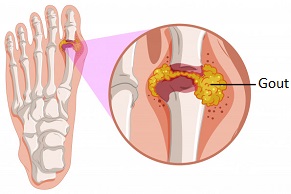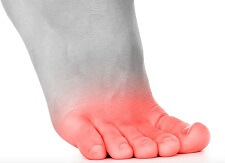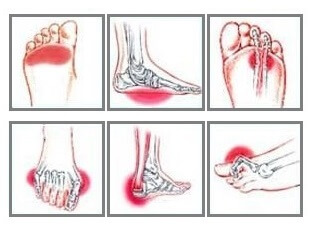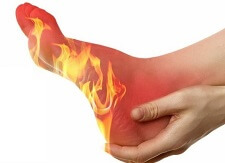- Home
- Common Foot Problems
- Gout Foot
- Gout Prevention
Gout Prevention
Written By: Chloe Wilson BSc(Hons) Physiotherapy
Reviewed By: FPE Medical Review Board

Gout prevention strategies help to reduce the incidence and recurrence of this common form of arthritis.
Gout affects approximately 4% of adults, but this figure rises dramatically to 20% for those who have a family history of gout.
Recurrence rates are high with around 37% of gout sufferers experiencing at least one flare up within a year. This makes gout prevention extremely important.
Gout can affect any joint, but most commonly affects the extremities (hands and feet), which is thought to be due to their lower temperatures, or the knee. The most common place to get gout is in the big toe, known as Podagra.
What Causes Gout?
There are a number of different causes and risk factors for gout which include:
- High Uric Acid Levels: build-up of uric acid in the body
- Sodium Urate Crystals: form in joints causing inflammation and irritation
- Medical Conditions: e.g. high blood pressure, diabetes and kidney disease
- Diet: Consuming food and drink with high purine levels
- Medication: e.g. beta blockers, aspirin and cholesterol medication
- Obesity: BMI over 35
Common Gout Symptoms
Typical symptoms of gout usually develop suddenly and rapidly over a few hours, usually at night time, and include:

- Sudden, Intense Pain
- Redness & Inflammation
- Tenderness & Warmth To Touch
- Tophi: Lumps that form under the skin
- Fever
- Difficulty Walking: If the feet or knees are affected
Gout symptoms typically last for a week or two. Gout can occur anywhere in the body but most common affects the feet, especially the big toe, the knees and the hands.
Gout Prevention Strategies
There are a number of things you can do to reduce the risk of developing a gout attack. The best strategies for gout prevention are a combination of:
1. Medication
If you have had gout attacks in the past, then medication can really help with gout prevention. Medication to reduce uric acid levels helps prevent the formation of urate crystals as well as dissolving any existing crystals. Common prevention medications include allopurinol and febuxostat. These usually need to be taken daily and it can take a while to find the correct dosage for you.
Also discuss with your doctor whether any medications you are already taking are increasing your risk of gout, particularly if you have high blood pressure or high cholesterol. There may be alternatives you can take instead.
2. Diet
Avoiding food and drinks that are high in purine is a great gout prevention tactic. High purine foods include game meat, offal e.g. liver and kidney, oily fish, seafood and certain vegetables e.g. spinach.
Certain food and drink can actually help with gout prevention by lowering purine levels. Favorites include pineapple, cherry juice, low fat dairy products such as skimmed milk and low-fat yogurt, coffee and citrus fruits.
3. Drink Plenty Of Water
Keeping well hydrated reduces uric acid crystal formation in the kidneys and thus helps to prevent gout attacks. Aim to drink approximately 1.5 litres per day, more if it is hot.
4. Lose Excess Weight
Obesity often results in higher levels of uric acid and thus increases the risk of developing foot gout. Weight loss should be carefully controlled as crash dieting can actually increase the risk of developing the disease, and is only appropriate if you are overweight. Always talk to your doctor before embarking on weight loss programmes.
5. Supplements
Taking a daily dose of vitamin C has been shown to reduce the risk of developing gout by about 45%. There are also a number of supplements on the market which claim to help lower levels of uric acid - always consult your doctor before taking any supplements.
Find out which gout supplements work best and get the best reviews (link takes you to Amazon).
6. Think About What You Drink
Alcohol, particularly beer, stout and fortified wine all contain high levels of purine which can increase the risk of gout attacks.
And avoid fructose-sweetened food and drink such as soda, candy and some canned fruits as they also increase the risk of gout.
7. Exercise
Regular exercise has been shown helps to reduce the risk so is an important part of gout prevention strategies.
What Else Can Help?
All the gout prevention tools we have discussed here not only help to reduce the risk of developing gout, but can help to treat gout flare-ups. There are also other treatments that can help during a gout attack which we look at in the Gout Treatment section.
If you want to know more about gout and the causes, symptoms, diagnosis and treatment for gout attacks in specific joints, choose from:
- Gout Foot: including Podagra (big toe gout)
- Gout Knee
Always remember, gout prevention is better than cure, so don't wait until you have a gout attack, start reducing your risk now using the things we have discussed here.
Page Last Updated: 10/05/22
Next Review Due: 10/05/22
Related Articles
References
1. Rheumatology Journal: Frequency and risk factors of gout flares in a large population-based cohort of incident gout. By D. Rothenbacher, P. Primatesta, A. Ferreira, L. Cea-Soriano, L. García Rodríguez. May 2011
2. Arthritis Foundation: What Is Gout?
3. Journal of Advanced Research. Gout: An old disease in new perspective – A review. By Ragab G., Elshahaly M. & Bardinc T. September 2017
- Home
- Treatment Guide
- Gout Prevention






